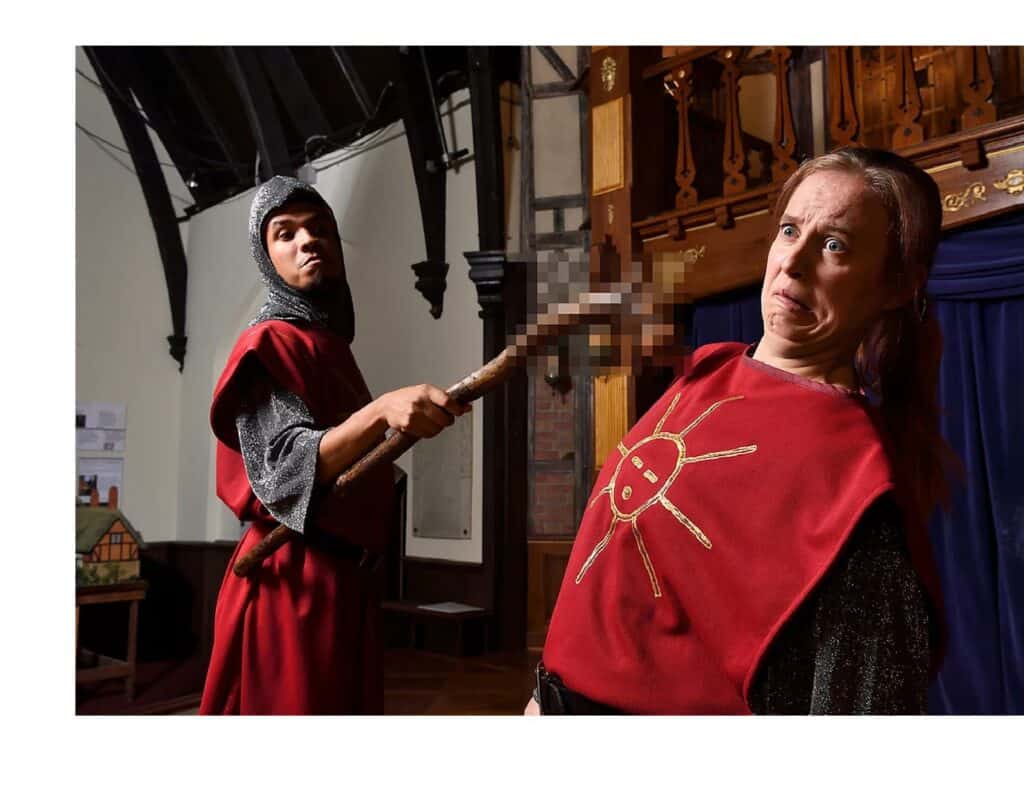An Old But Surprisingly Modern Comic Treasure: THE KNIGHT OF THE BURNING PESTLE at Baltimore Shakespeare Factory

Posted on BroadwayWorld.com November 3, 2019
The Knight of the Burning Pestle, Francis Beaumont‘s rarely-produced 1607 comedy, is receiving its all-time Baltimore premiere courtesy of Baltimore Shakespeare Factory, a high-spirited troupe who revel in slapdash performances laced with contemporary pop song at the interludes and sometimes in the performances. The slapdash notwithstanding, a serious dedication not just to the Bard but also to Elizabethan and Jacobean drama also animates them. The company’s performances, then, are an odd hybrid of serious and silly. But there could never be much doubt which part of the genome would predominate when it came to a play like this.
Consider the show’s emblem, the humble pestle, pictured – well, pixelated anyway (and for cause) – in the attached publicity photo. Usually accompanied in everyday usage by the prefatory words “mortar and,” the pestle is an instrument for crushing and mixing herbs or chemicals or pharmaceuticals, and bears some resemblance to engorged male genitalia. We can be sure that Beaumont chose the object with a clear understanding of that resemblance, but with an eye to making it symbolic in a way that included the vulgarity but incorporated much more.
The word first appears in the script of the play in a speech by Nell (Kerry Brady), the wife of a grocer called George, aka The Citizen (David Forrer). And what are the two of them doing in the play? One may well ask. They appear initially as the all-time least cooperative audience-members ever, and insist on coming up on the stage, and both talking over and taking over the entertainment, a play called The London Merchant, evidently feeling that they know more about London commerce than the actors. Yet they are not looking for greater realism, as one might expect; they want instead to glorify the London mercantile class and the London citizenry by endowing their avatar with gaudier adventures than The London Merchant‘s inhabitants would ever have encountered. Nell is keen on giving the couple’s apprentice, a young man named Rafe (Warren Harris), a big role, and it is as part of Nell’s aspiration toward outsized heroism that she suggests: “Let him kill a lion with a pestle, husband; let him kill a lion with a pestle.” (Perhaps pestles figured in some way in the 17th century grocer’s trade?) The next thing we know, Rafe appears decked out as a knight brandishing the pestle, now morphed into what amounts to a sex toy, at the end of a pike as his heraldic emblem, an in-your-face way of puncturing the pretensions of the more conventional entertainment and of the class of spectators who would have come to the theater to see it. (That supposedly more conventional entertainment is itself, incidentally, a parodic send-up of a bona fide conventional entertainment, a play by Thomas Heywood called The Four Prentices of London (1600).)
It works particularly well in this production that Rafe and the character he portrays, the Knight of the Burning Pestle, are never in on the joke, any more than Don Quixote, the obvious model for Knight, is in on Cervantes’ joke. (Don Quixote, the Spanish classic, was just out and not yet published in English translation, but the resemblances are so strong it is inescapable that Beaumont was familiar with its hero.) Instead, Rafe, as portrayed by Harris (pictured above with cast-member Sarah Robinson), is a wide-eyed would-be knight errant, fearlessly and unironically roaming Waltham Forest (north of London), which he insists on viewing as Waltham Desert, protecting damsels and others in distress. One can see the dramatic effect Nell is aiming for with her casting of Rafe, who never breaks character while portraying the knight. In a different play, Harris could play an admirable and brave hero straight. Here, of course, the concept of a grocer’s apprentice playing knight errant can only be ridiculous, particularly when he is liberating the “captives” in the “cave” of the “giant” Barbaro, more commonly known as customers of a barbershop. In 1607, of course, barbers were also what we know today as health care providers, so there is a lot of low humor in showing the “captives” as patients for the treatment of venereal diseases. But Harris goes through all the bawdy misapprehensions with a straight face and a heroic line delivery.
While all this tomfoolery is happening, the players are still gamely trying to put on The London Merchant, a more routine tale of young lovers Jasper (Adam Henricksen) and Luce (Jackie Madejski), Luce’s father Venturewell, the eponymous London merchant (Jim Knost) and Humphrey (Katie Rey Bogdan), the prosperous suitor for Luce’s hand favored by Venturewell. Somehow, in preposterous and melodramatic fashion, the lovers must succeed despite her father being a stereotypical senex iratus, an angry old man whose sole dramatic function is to unsuccessfully impede the lovers. But here the London Merchant cast will not only need to fight their way through melodramatic claptrap – but also through the additional traffic on the stage created by the constant incursions of the Burning Pestle tale and through some effort on the part of the Knight to intervene in the Jasper-and-Luce story and through the constant intrusions of Nell and George, whose antics make one long for the far less intrusive disruptions of simple cellphones amongst most modern audiences.
From this account it is self-evident that The Knight of the Burning Pestle, even if four centuries old, is quite modern in the way it courts fourth-wall violations and meta-narratives. In fact the whole play is a giant, continuing fourth wall violation with attitude, and the performance by BSF only makes it more so. The text has been modernized to bring the once-topical jokes up to date. For instance, a joke about (I think) London mayor Dick Whittington is swapped out for a jibe at Sheila Dixon. And the copious songs Beaumont wrote, especially for Jasper’s dad, the roisterer Merrythought (Cheryl J. Campo) (Merrythought breaks into song 31 times in the original script), have all been scrapped and lost, in favor of repeated raids on the modern pop and rap songbook. (Though, to be fair, Beaumont was just as assiduously raiding and adopting from the pop songbook of his own day.) And this process intensifies in the pre-performance and intermission singing, which aggressively courts the audience not to be mere spectators but to engage in a singalong. The distinction between audience and performers is thus continually assaulted throughout the evening. We are being bullied not to play the role of a 21st Century audience watching performers stage a 17th Century play, but instead to join a group experience that takes place in an undefined common time. There are those who adore this sort of thing; if you don’t, the experience of not being left alone and protected by the fourth wall will grate.
My own take is that this approach is founded on a degree of distrust of the audience – that there is a fear that if the audience were confronted with the difficulty of a text filled with in-jokes that are no longer topical and songs its members have not heard before, and without a spoonful of modern sugar to help the ancient medicine go down, the audience could not handle it. I’m not convinced; I think dramaturgy could be deployed to combat most of these problems. But that approach is enshrined in BSF’s ethos, and it seems pointless to argue – and it should be mentioned as well that at the same time as it engages in these efforts to make Shakespearean-era drama more accessible, BSF is the only local company that frequently takes on Shakespeare in Original Pronunciation. I guess each company driving in this theatrical lane chooses its own compromises with modernity.
Meanwhile, we are left to judge this production on its own terms. And perhaps the first thing to do is utter thanks that the play is being revived at all. As I stated at the outset, it’s rarely produced, and it certainly deserves the occasional outing, if only as a reminder that our forbears were just as interested in trying experiments with theatrical genre and form as we are. And yes, let’s acknowledge that Shakespeare among others allowed little, somewhat ceremonious, fourth wall violations, for instance with prologues and epilogues that directly addressed the audience. But Knight is a series of big departures that makes anything comparable I can think of in Shakespeare or Jonson seem tame. It’s impossible not to be intrigued by Knight‘s originality, and amused by its contrived chaos.
As to the performances, if one accepts the desirability of genderless casting (I remain unenthused most of the time) and the undoubted necessity of doubling, the cast members seem well-selected for their tasks. I’ve already expressed my admiration for Warren Harris. To name a few of the other standouts, Cheryl Campo’s unabashedly unhinged portrayal of Old Merrythought kept me smiling; Jackie Madejski’s game turns as the put-upon Luce and the supposedly villainous Barber were hilarious, and Kerry Brady and David Forrer made hay out of annoying, interfering, ill-bred, and uninformed characters redeemed by their enthusiasm, their partisanship for their hometown, and their delight at Rafe.
If you aren’t put off by the honestly debatable choices I’ve mentioned, you’ll have a great time rediscovering an old but surprisingly modern comic treasure.
Copyright (c) Jack L. B. Gohn, except for production photo.
Photo credit: Will Kirk

 I lived in London and Vienna before coming to the United States, and grew up mainly in Ann Arbor. I was writing plays and stories as early as grade school. My undergraduate years at the University of Pennsylvania, where I first reviewed theater, for the college paper, were succeeded by graduate study at the Johns Hopkins University, where I earned a doctorate in English Literature.
I lived in London and Vienna before coming to the United States, and grew up mainly in Ann Arbor. I was writing plays and stories as early as grade school. My undergraduate years at the University of Pennsylvania, where I first reviewed theater, for the college paper, were succeeded by graduate study at the Johns Hopkins University, where I earned a doctorate in English Literature.